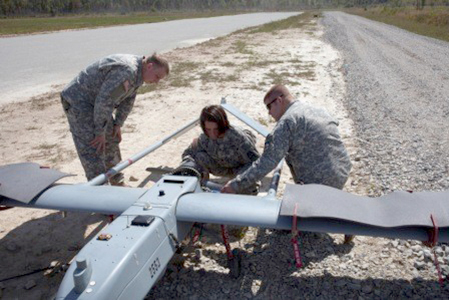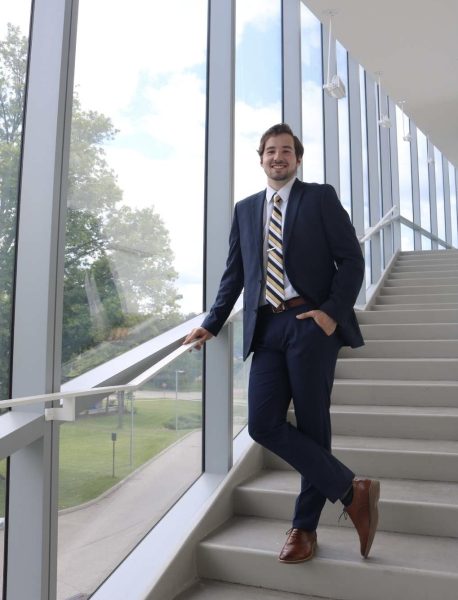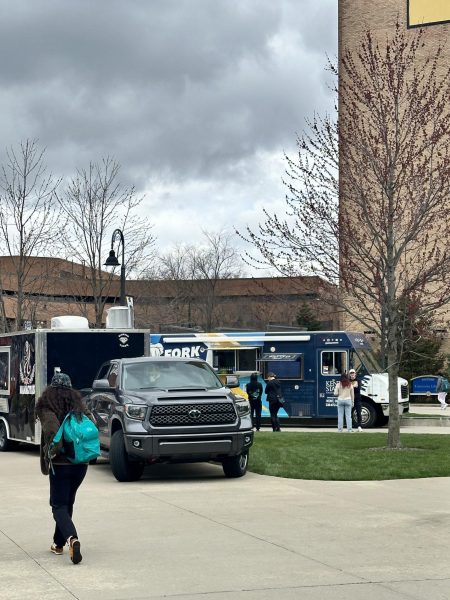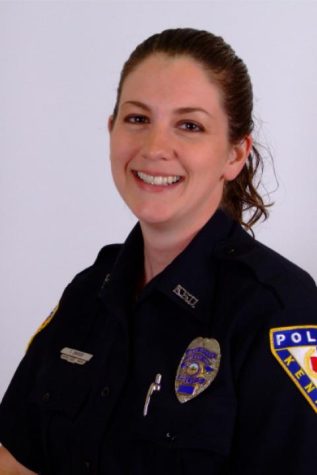New minor opens doors — and skies — for students seeking real aeronautics experience

A drone being examined at Camp Atterbury in Indiana, one of the test ranges of the Uunmanned Aircraft Systems Center. Photo courtesy of Ohio/Indiana UAS Center program manager Brittany Peterson.
October 30, 2013
Kent State has joined the aeronautics trend that has swept the state of Ohio with the addition of a minor program in unmanned aircraft systems.
“I was interested when I first heard about it because UAVs are taking a larger role in our national air system,” sophomore aeronautics major Austin Stevanus said. “I’m interested in learning more about how they operate and what daily life entails of being a drone operator. UAVs seems an exciting field especially as we’re moving toward that.”
The Faculty Senate approved the minor, part of the College of Applied Engineering, Sustainability and Technology, during a meeting last December. Paul Farrell, senate chair, said in an email the senate approved it because staffing plans were adequate, there was demand for the minor and it could lead to improved potential employment for graduates.
Outlook for graduates
- In the first three years of integration, more than 70,000 jobs will be created in the United States with an economic impact of more than $13.6 billion.
- By 2025, the Association for Unmanned Vehicle Systems International foresees 103,776 jobs created and an economic benefit of $82 billion.
- The worldwide market for unmanned aerial vehicles will grow to a cumulative total of $71 billion from 2010-2020.
- Tax revenue to the states will total more than $482 million in the first 11 years following integration (2015-2025).
Richard Mangrum, faculty senate representative for the College of Applied Engineering, Sustainability and Technology, told the senate about how the spread of UAVs (unmanned aircraft vehicles) for those devices is going to be significant after the year 2015.
“This is our attempt to start offering an education and get out in the front of what’s going to be an incredibly high-demand career field domestically and abroad,” Mangrum said.
John Duncan, assistant professor of aeronautics, is the lead faculty member on the minor and said students will be able to learn the structure and function of unmanned aerial systems as well as characteristics of onboard sensors, federal regulations regarding their operation and performance and navigation.
“This is big and up and coming,” Duncan said. “What’s happened in the past couple of years is the coming together of technology and commercial need to make unmanned vehicles available to the general public commercially.”
Uses for UAVs have traditionally been in the form of drones, armed with explosives for military purposes for example, the Medina County Sheriff’s Office is one out of a six entities in Ohio authorized by the FAA to fly an unmanned aircraft system.
However, commercial uses of UAVs are expected to be applied to precision agriculture and public safety. Agricultural monitoring, disaster management, law enforcement, aerial imaging, wildfire mapping, oil and gas explosion, weather monitoring and homeland security are among the fields expected to profit from UAV integration into national airspace.
“Drone is the D-word in the commercial business,” Duncan said. “When you say the word ‘drone,’ people think of weapons and spying. In the commercial sector, there’s no weapons of any kind on those.
“If it’s dirty, dangerous or dull, it is better to have a robotic aircraft doing it than a human,” Duncan said about the advantage of remote-controlled UAVs.
Kent State and other universities plan to capitalize on teaching UAV operation for their commercial potential once the federal officials allow them to be integrated into the National Airspace by 2015.
Now, the Federal Aviation Administration is tasked with figuring out how to integrate unmanned aircrafts into the current airspace and determine who should be allowed to use them and how, Duncan said.
var so = new SWFObject(‘http://www.staterinteractive.com/player.swf’,’mpl’,’600′,’450′,’9′);
so.addParam(‘allowscriptaccess’,’always’);
so.addParam(‘allowfullscreen’,’true’);
so.addParam(‘flashvars’,’&file=103013_drones_PKG.flv&image=http://www.staterinteractive.com/photos/spring12/TV2.jpg&frontcolor=6666FF&lightcolor=EEEEEE&skin=http://www.staterinteractive.com/snel.swf&streamer=rtmp://flashmedia.kent.edu/fms-jmc/kentWired’);
so.write(‘kentwired’);
Video by Danielle Slack
Testing the aircraft
Kent State’s aeronautics program has been involved with the unmanned aircraft trend even before implementing the minor.
The college and 88 additional entities — 10 of them other colleges — have partnered with Ohio and Indiana to become part of one of six unmanned aircraft system testing and development sites. The states submitted their proposal and await the FAA’s December deadline for approval.
The Medina County
Sheriff’s Department
The Medina County Sheriffs’ department is one out of a six entities in Ohio authorized by the FAA to fly an unmanned aircraft system.
Medina County Sheriff Tom Miller said the sheriff’s department received the UAS from Vista UAS, a company that manufactures the systems in Rittman, Ohio, after eight years negotiations.
“It can be cost effective in terms of search and rescue,” said Miller as the reason for pursuing the UAS. “If we have a missing child or an Alzheimer’s patient in a wooded area in the county, it can be used to quickly search the area.”
The sheriff’s office joins the Ohio Department of Transportation, Ohio University, Lorain Community College, Sinclair Community College, Eastern Gateway Community College and one other police department in the state to be authorized to fly their UAS in national airspace.
Richard Honeywell, director of the new Ohio/Indiana UAS Test Center and Complex in Springfield, said Kent State had model and simulation capabilities that were valuable in the state’s efforts to be chosen as a testing site.
He said Springfield’s proximity to robust aerospace research and supply chain capabilities laid the foundation for the proposal.
“We’re in the position of getting businesses ready so that they can move forward into that market,” Honeywell said.
The center’s proximity to Dayton, considered the birthplace of aviation, will allow access to the Wright Patterson Air Force Base, the Air Force Institute of Technology and the many drone entrepreneurs the city has to offer. Honeywell said Glenn Research Center in Cleveland, and Ohio’s being No. 1 in the supply chain of aircraft manufacturers, will serve to be an advantage.
Unmanned aircrafts can be as big as a 113-foot Boeing 737 jet or smaller than a remote-controlled airplane. Duncan said flying a UAV is like flying a remote-controlled airplane but with sophisticated onboard sensors.
“The actual physical manipulation of the aircraft is simple, but the big deal from a flight training point of view — if you are operating in federal airspace — you need to know all the federal regulations and comply with the FAA and air traffic control,” Duncan said.
From the air to the classroom
Duncan said with the FAA’s pending regulations, the College of Aeronautics has decided not to launch the minor until Fall 2014. He said the minor will remain instructional until the FAA opens the airspace but could develop into a major in the future.
“The big thing that holds us up now is that the FAA may say that UAVs can only be used under 400 feet at direct eye contact, which will limit the users and probably drive the certification of pilots,” he said.
The minor is slated to provide options for students in the long run.
“Once students graduate, they get put on a waiting list for hire, which could be one to two years,” said Duncan referring to the school’s graduates in air traffic control. “That’s why we’re encouraging them to get this minor. It gives them another route to do something if they’re not hired” by the FAA.
Brandon Wish, a senior aeronautics major in aviation management, said he was interested in the minor as it is the future of aviation.
“I think it’s booming right now, and I definitely think it’s going to be the future,” he said. “I really wanted to do it because I was like, ‘This is going to be huge one day.’ To get my foot in the door and get a minor in it, I think that would be really big. But with graduating this spring, it wasn’t possible.”
Duncan said if the unmanned aircraft systems minor develops into a major, he sees Kent State purchasing a small UAV like a quadcopter or remote-controlled plane with a small frame, wings and tail, which run around $300.
“At some point, we’ll have to go with both because that’s what will be out in the world,” he said.
Honeywell said with the commercialization of UAVS, universities will not be the only thing to profit. The potential for their uses is infinite.
“You really just start looking at it and say, ‘Gee, if I could do this with a UAS, how cold do this more efficiently?’” Honeywell said. “It really goes to what is the extent of your imagination.”
Contact Madeleine Winer at [email protected].
























